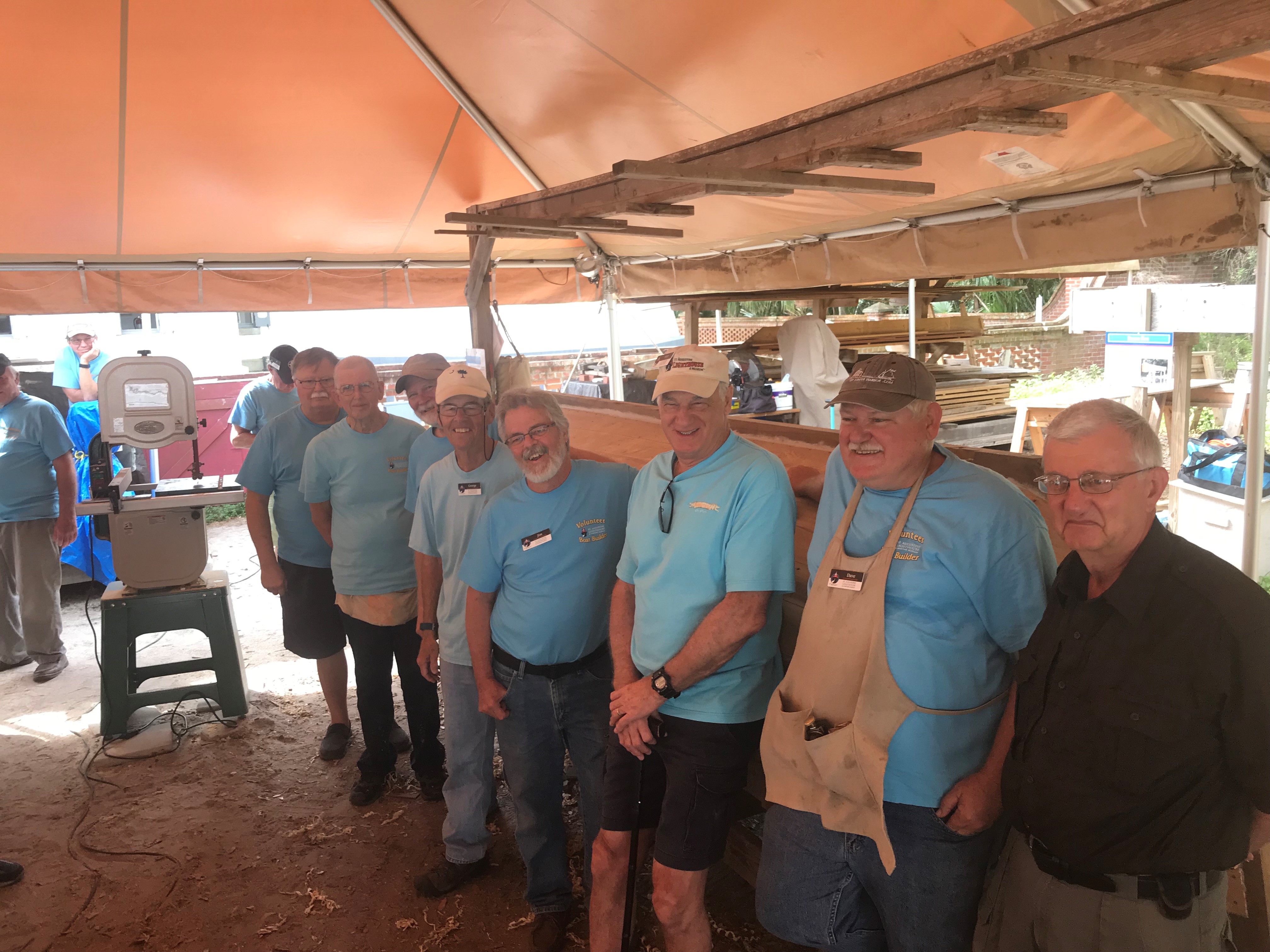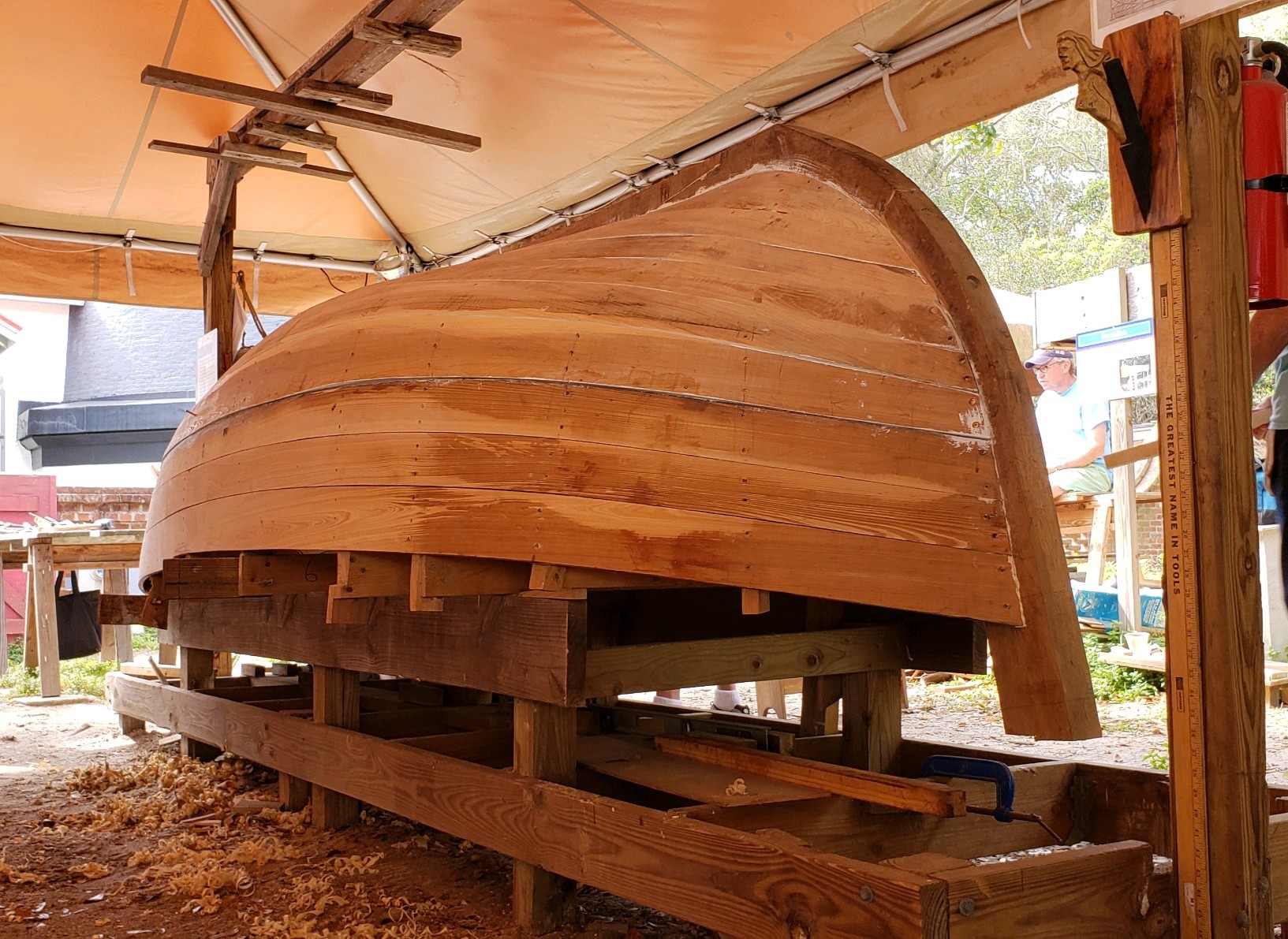Vessel built at the St. Augustine Lighthouse & Maritime Museum for re-enactment group
Heritage Boatworks volunteers at the St. Augustine Lighthouse & Maritime Museum have completed a replica of a 1760 Yawl wooden sailing vessel. This commission for HMS Bellisarius, a re-enactment group, was handcrafted for near three years.
“Using plans from 1760, the boat builders have constructed a working Yawl. These boats were adopted by the British Navy in 1701 as the smallest class of boats aboard a warship. They would have been a common sight on the St Augustine waterfront during the time of British control, from 1763 to 1783,” explained John Clarke, Maritime Activities Coordinator at the nonprofit Museum.

The skilled volunteer boatwrights of Heritage Boatworks at the St Augustine Lighthouse & Maritime Museum are affixing the “whiskey plank” to a replica British Yawl that they have handcrafted over the past three years. Pictured is the attachment of the last plank, technically called a shutter plank. It earned the colorful nickname of “whiskey plank” when boatwrights celebrated its placement with a “spirited” toast.
This British yawl, dating to 1760, was a standard type used by the Royal Navy as a ship’s boat. The vessel type originally came from Norway, where it was known as a “yole” and was clinker-planked (plank edges overlapping), double-ended and highly seaworthy.
The yawl spread through Ireland and England and in 1701 it was officially adopted by the British Navy. Naval yawls were the smallest class of boats on board a warship. The first Naval yawls were almost double-ended (unique among naval boats) and featured curved sternposts and small transoms. They continued to evolve over the course 18th century: Planking transitioned from clinker to carvel, the sternpost was straightened, transoms were somewhat widened, and overall size increased to a standard 26′ long and 6′ 6″ wide by 1800. The 1760 yawl, whose lines are reproduced here is a transitional type, carvel-built and just over 14′ long and 4′ 6″ wide. Yawls were highly regarded by naval officers who frequently requested them in place of longboats.
To view this long-standing maritime tradition, museum guests can watch the boatbuilders from 9 a.m. to 12 p.m. Tuesday through Thursday in the Heritage Boatworks tent on the museum grounds.
In addition to the Yawl, the team of 30+ volunteers also are creating a small Penobscot rowboat and a wooden strip kayak. The Museum hosts an annual drawing for a chance to win one of the boats.

The completed 1760 Yawl in the Heritage Boatworks tent at the St. Augustine Lighthouse & Maritime Museum. More than a dozen volunteers built this wooden vessel for more than three years. It was commissioned by a re-enactment group.
“I started volunteering with Heritage Boatworks about four years ago. I was drawn to the history, boats and building … and I’ve been here three morning a week every since,” explained Jim Millette, Museum Volunteer. “We had more than a dozen volunteers working on the Yawl over the past three years. My favorite part is shaping the planks and seeing how the rough wooden planks can be sharing into smooth components of the hull.”
Heritage Boatworks is sponsored in part by the State of Florida, Department of State, Division of Cultural Affairs and the Florida Council on Arts & Culture.
For more details about the St. Augustine Lighthouse & Maritime Museum, visit staugustinelighthouse.org or call 904-829-0745. Stay updated on social media at facebook.com/staugustinelighthouse, Instagram.com/stauglighthouse and twitter.com/firstlighthouse

This photos shows a steaming of the plank on the 1760 Yawl in 2019. Heritage Boatworks volunteers wrap the wooden plank in thick plastic and apply hot steam to help the wood take the shape needed to create the boat replica.
ABOUT THE ST. AUGUSTINE LIGHTHOUSE & MARITIME MUSEUM:
A defensive and navigation tool and landmark of St. Augustine for 145 years, the St. Augustine Light Station watches over the waters of the Nation’s Oldest PortTM. Through interactive exhibits, guided tours and maritime research, the 501(c)(3) nonprofit St. Augustine Lighthouse & Maritime Museum, Inc. is on a mission to discover, preserve, present and keep alive the stories of the Nation’s Oldest Port® as symbolized by our working lighthouse. We are the parent organization to the Lighthouse Archaeological Maritime Program (LAMP) and an affiliate of the Smithsonian Institution. (StAugustineLighthouse.org)
ABOUT THE AMERICAN ALLIANCE OF MUSEUMS:
The St. Augustine Lighthouse & Maritime Museum is accredited by the American Alliance of Museums (AAM), the highest national recognition afforded the nation’s museums. The American Alliance of Museums has been bringing museums together since 1906, helping to develop standards and best practices, gathering and sharing knowledge, and providing advocacy on issues of concern to the entire museum community. As the ultimate mark of distinction in the museum field, accreditation signifies excellence and credibility. Accreditation helps to ensure the integrity and accessibility of museum collections and reinforces the education and public service roles of museums and promote good governance practices and ethical behavior. Representing more than 35,000 individual museum professionals and volunteers, institutions, and corporate partners serving the museum field, the Alliance stands for the broad scope of the museum community. (www.aam-us.org)

